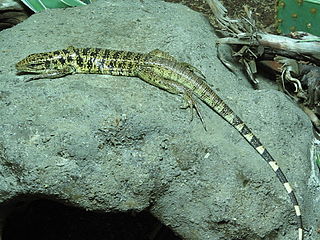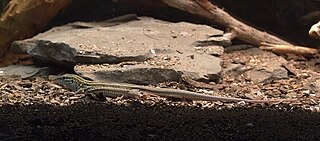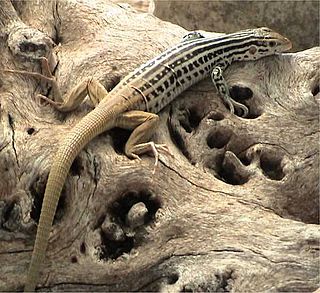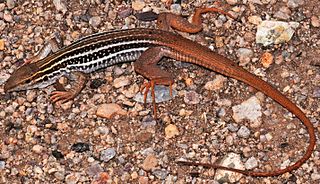
Teiidae is a family of autarchoglossan lizards native to the Americas. Members of this family are generally known as whiptails or racerunners; however, tegus also belong to this family. Teiidae is sister to the Gymnopthalmidae, and both families comprise the Teiioidea. The Teiidae includes several parthenogenic species – a mode of clonal reproduction. Presently, the Teiidae consists of approximately 150 species in eighteen genera.

Cnemidophorus is a genus of lizards in the family Teiidae. Species in the genus Cnemidophorus are commonly referred to as whiptail lizards or racerunners. The genus is endemic to South America, Central America, and the West Indies.

Aspidoscelis is a genus of whiptail lizards in the family Teiidae.

The western whiptail is a species of lizard in the family Teiidae. The species is found throughout most of the southwestern United States and northern Mexico. Most of its populations appear stable, and it is not listed as endangered in any of the states comprising its range. It lives in a wide variety of habitats, including deserts and semiarid shrubland, usually in areas with sparse vegetation; it also may be found in woodland, open dry forest, and riparian growth. It lives in burrows. Major differences between this species and the checkered whiptail include the lack of enlarged scales anterior to the gular fold and the presence of enlarged postantebrachial scales. It was previously known as Cnemidophorus tigris, until phylogenetic analyses concluded that the genus Cnemidophorus was polyphyletic. Since it does not migrate, a number of forms have developed in different regions, several of which have been given subspecific names – for example the California whiptail, Aspidoscelis tigris munda.

The desert grassland whiptail lizard is an all-female species of reptiles in North America. It was formerly placed in the genus Cnemidophorus. A common predator of the whiptail lizard is the leopard lizard, that prey on A. uniparens by using ambush and stalk haunting tactics. These reptiles reproduce by parthenogenesis. In this process, eggs undergo a chromosome doubling after meiosis, developing into lizards without being fertilized. However, ovulation is enhanced by female-female courtship and mating (pseudo-copulation) rituals that resemble the behavior of closely related species that reproduce sexually.

The orange-throated whiptail is a species of lizard in the family Teiidae. The species was previously placed in the genus Cnemidophorus. Three subspecies are recognized as being valid, including the nominotypical subspecies.

James Ray Dixon was professor emeritus and curator emeritus of amphibians and reptiles at the Texas Cooperative Wildlife Collection at Texas A&M University. He lived in El Campo, Texas, throughout most of his childhood. He published prolifically on the subject of herpetology in his distinguished career, authoring and co-authoring several books, book chapters, and numerous peer reviewed notes and articles, describing two new genera, and many new species, earning him a reputation as one of the most prominent herpetologists of his generation. His main research focus was morphology based systematics of amphibians and reptiles worldwide with emphasis on Texas, US, Mexico, Central America, and South America, although bibliographies, conservation, ecology, life history and zoogeography have all been the subjects of his extensive publications.

The Texas spotted whiptail is a species of long-tailed lizard, in the family Teiidae. The species is endemic to the south central and southwestern United States and northern Mexico. Six subspecies are recognized as being valid.

The Laredo striped whiptail is a species of lizard found in the southern United States, in Texas, and northern Mexico in Coahuila, Nuevo Leon, and Tamaulipas. Some sources believe it to be the result of extensive hybridization between the Texas spotted whiptail, Aspidoscelis gularis and the six-lined racerunner, Aspidoscelis sexlineatus. It is one of many lizard species known to be parthenogenic.

The New Mexico whiptail is a female-only species of lizard found in New Mexico and Arizona in the southwestern United States, and in Chihuahua in northern Mexico. It is the official state reptile of New Mexico. It is one of many lizard species known to be parthenogenetic. Individuals of the species can be created either through the hybridization of the little striped whiptail and the western whiptail, or through the parthenogenetic reproduction of an adult New Mexico whiptail.
The plateau spotted whiptail is a species of lizard found in the southern United States in Texas, and in northern Mexico in Chihuahua and Coahuila. It is known to hybridize with the Eastern Spotted Whiptail, Cnemidophorus gularis, but is considered to be a distinct species due to phenotypic characteristics.

The checkered whiptail is a species of lizard found in the southwestern United States in Colorado, Texas and New Mexico, and in northern Mexico in Chihuahua and Coahuila. Many sources believe that the species originated from the hybridization of the marbled whiptail, Aspidoscelis marmorata, the plateau spotted whiptail, Aspidoscelis septemvittata, and possibly the six-lined racerunner, Aspidoscelis sexlineata. It is one of many lizard species known to be parthenogenic. It is sometimes referred to as the common checkered whiptail to differentiate it from several other species known as checkered whiptails.

The six-lined racerunner is a species of lizard native to the United States and Mexico.

The little striped whiptail is a species of lizard found in the southwestern United States and in northern Mexico. A significant amount of research was done on the species during the mid-1990s, with several new subspecies being added, many of which some sources consider to be distinct enough to warrant full species status, and the research is ongoing. It is called little to distinguish it from many other species known as striped whiptails and to indicate that it is the smallest of those species.

The Trans-Pecos striped whiptail is a subspecies of the little striped whiptail lizard. It is found in the semiarid, sandy habitats of the Chihuahuan Desert, in the United States from West Texas across southern New Mexico to Arizona, as well as northern Mexico. It is sometimes referred to as the Arizona striped whiptail or seven-striped whiptail.

The canyon spotted whiptail is a species of lizard in the family Teiidae. The species is native to northwestern Mexico and the adjacent southwestern United States.

Aspidoscelis costatus, also known as the western Mexico whiptail, is a species of whiptail lizard endemic to Mexico, including Guerrero, Morelos, and Puebla in southern Mexico, as well as other Mexican states. Its range spans both temperate and tropical habitats, and even densely populated urban areas. Its common name, the Western Mexico Whiptail, can easily be confused with the Western Whiptail, which refers to a different lizard, Aspidoscelis tigris.
Aspidoscelis danheimae, also known commonly as the Isla San José whiptail, the San Jose Island blue-throated whiptail, and el huico de la Isla San José in Spanish, is a species of lizard in the family Teiidae. The species is endemic to Isla San José in Baja California Sur, Mexico.
Aspidoscelis rodecki, also known commonly as Rodeck's whiptail, is a species of lizard in the family Teiidae. The species is endemic to Mexico.

Aspidoscelis sackii, known commonly as Sack's spotted whiptail, is a species of lizard in the family Teiidae. The species is endemic to Mexico. There are three recognized subspecies.
















